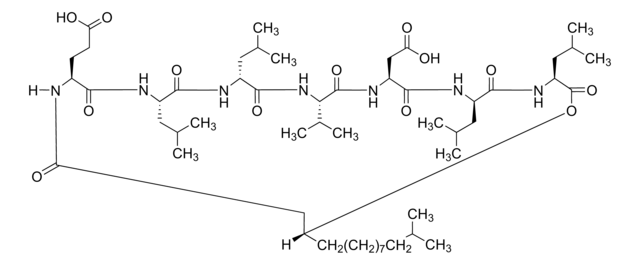おすすめの製品
product name
ラムノリピド,
由来生物
Pseudomonas aeruginosa
品質水準
形状
solid/granular
環境により配慮した代替製品の特徴
Design for Degradation: Greener alternative product characteristics
Learn more about the Principles of Green Chemistry.
sustainability
Greener Alternative Product
環境により配慮した代替製品カテゴリ
, Aligned
輸送温度
ambient
保管温度
room temp
類似した製品をお探しですか? 訪問 製品比較ガイド
関連するカテゴリー
詳細
Rhamnolipid biosurfactants are glycolipids containing L-rhamnose and ß-hydroxyl fatty acids, with amphiphilic properties (both hydrophilic and hydrophobic). This rhamnolipid product has been purified from Pseudomonas aeruginosa and contains a mixture of rhamnolipids with fatty acids of varying tail length. They are highly biodegradable, non-toxic, and renewable. Functional roles include bioactive, surfactant and emulsifier. Rhamnolipids provide good detergency/foaming/wetting, stable microemulsion formation, and solubility under high alkalinity. They are mild with skin-friendly attributes. Surfactant and emulsion properties of rhamnolipids include reducing the surface tension of water to 25 to 40 mN/m, having a CMC of 5-380 mg/L, and decreasing the interfacial tension of oil and water to <1 dyne/cm. Rhamnolipid biosurfactants are superior to synthetic surfactants for several reasons: their CMC is 10-100 times lower than that of traditional chemical surfactants (meaning much less material is required to achieve reductions in surface tension/interfacial tension); they are easily biodegradable with very low toxicity (having higher EC50 values); they are not as affected by temperature, pH and salinity; and they are sustainably produced.
We are committed to bringing you Greener Alternative Products, which adhere to one or more of The 12 Principles of Greener Chemistry. This product has been enhanced for hydrocarbon degradation. For more information see the paper Environmental applications of biosurfacants: recent advances, and the many other articles available at: AGAE Technologies
We are committed to bringing you Greener Alternative Products, which adhere to one or more of The 12 Principles of Greener Chemistry. This product has been enhanced for hydrocarbon degradation. For more information see the paper Environmental applications of biosurfacants: recent advances, and the many other articles available at: AGAE Technologies
アプリケーション
Rhamnolipids can be used in pharmaceuticals, cosmeceuticals, cosmetics, personal products, environmental bioremediation, the petroleum industry, household cleaners, food and beverage processing, agriculture and horticulture, therapeutics, nanotechnology, the polymer industry, cryo-protectants, the mining industry, biofuels, ethanol production, microbial fuel cells, protein research, and neural stem cell studies.
法的情報
Product of AGAE Technologies
保管分類コード
11 - Combustible Solids
引火点(°F)
Not applicable
引火点(℃)
Not applicable
適用法令
試験研究用途を考慮した関連法令を主に挙げております。化学物質以外については、一部の情報のみ提供しています。 製品を安全かつ合法的に使用することは、使用者の義務です。最新情報により修正される場合があります。WEBの反映には時間を要することがあるため、適宜SDSをご参照ください。
Jan Code
R95DD-10MG:
試験成績書(COA)
製品のロット番号・バッチ番号を入力して、試験成績書(COA) を検索できます。ロット番号・バッチ番号は、製品ラベルに「Lot」または「Batch」に続いて記載されています。
[Factor VIII inhibitor postpartum].
I Ohkubo et al.
[Rinsho ketsueki] The Japanese journal of clinical hematology, 27(9), 1596-1602 (1986-09-01)
Roger Marchant et al.
Biotechnology letters, 34(9), 1597-1605 (2012-05-24)
Glycolipid biosurfactants produced by bacteria and yeasts provide significant opportunities to replace chemical surfactants with sustainable biologically produced alternatives in bulk commercial products such as laundry detergents and surface cleaners. Sophorolipids are already available in sufficient yield to make their
Metabolism of isoprenaline in the intestine.
C F George et al.
The Journal of pharmacy and pharmacology, 26(4), 265-267 (1974-04-01)
Magdalena Pacwa-Płociniczak et al.
International journal of molecular sciences, 12(1), 633-654 (2011-02-23)
Increasing public awareness of environmental pollution influences the search and development of technologies that help in clean up of organic and inorganic contaminants such as hydrocarbons and metals. An alternative and eco-friendly method of remediation technology of environments contaminated with
Markus Michael Müller et al.
Journal of biotechnology, 162(4), 366-380 (2012-06-26)
The demand for bio-based processes and materials in the petrochemical industry has significantly increased during the last decade because of the expected running out of petroleum. This trend can be ascribed to three main causes: (1) the increased use of
ライフサイエンス、有機合成、材料科学、クロマトグラフィー、分析など、あらゆる分野の研究に経験のあるメンバーがおります。.
製品に関するお問い合わせはこちら(テクニカルサービス)







